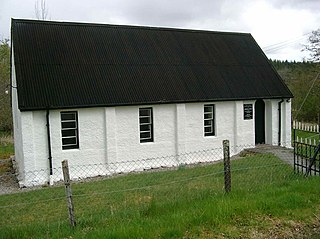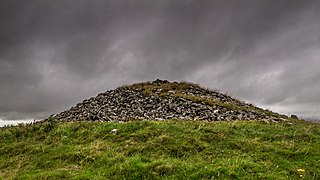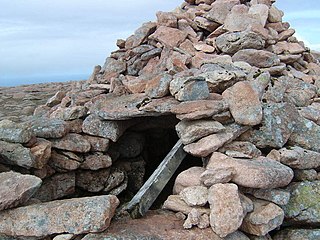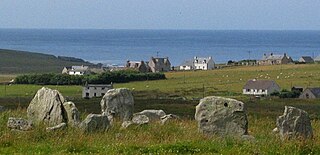 W
WBargrennan chambered cairns are a class of prehistoric chambered cairns found only in south-west Scotland, in western Dumfries and Galloway and southern Ayrshire. They form a separate group from the Clyde cairns which are found along the coast of western Britain. Unlike Clyde cairns, Bargrennan monuments are passage graves, with one or more chambers set into a round cairn. As well as being structurally different, Bargrennan cairns are separated from Clyde cairns by their siting and distribution; they are found in upland, inland areas of Galloway and Ayrshire. Murray suggests that there are around twelve Bargrennan monuments in south-west Scotland. She also notes that as sheep rees are often built into and over these types of cairns, more are likely to have been lost under shepherd's buildings.
 W
WBarpa Langass, is a Neolithic chambered cairn on the Isle of North Uist in the Outer Hebrides of Scotland. It measures about 72 feet in diameter by 18 feet in height, and is around 5,000 years old. The roof is constructed of two massive slabs with a third slab superimposed.
 W
WBlackhammer Chambered Cairn is a Neolithic cairn on Rousay, in Orkney, Scotland. It is a scheduled monument in the care of Historic Environment Scotland.
 W
WCairnderry chambered cairn is a chambered cairn in Dumfries and Galloway. It is a Bargrennan cairn, a type of Neolithic or early Bronze Age monument only found in south west Scotland.
 W
WCairnholy is the site of two Neolithic chambered tombs of the Clyde type. It is located 4 kilometres east of the village of Carsluith in Dumfries and Galloway, Scotland. The tombs are scheduled monuments in the care of Historic Scotland.
 W
WThe Clava cairn is a type of Bronze Age circular chamber tomb cairn, named after the group of three cairns at Balnuaran of Clava, to the east of Inverness in Scotland. There are about 50 cairns of this type in an area round about Inverness. They fall into two sub-types, one typically consisting of a corbelled passage grave with a single burial chamber linked to the entrance by a short passage and covered with a cairn of stones, with the entrances oriented south west towards midwinter sunset. In the other sub-type an annular ring cairn encloses an apparently unroofed area with no formal means of access from the outside. In both sub-types a stone circle surrounds the whole tomb and a kerb often runs around the cairn. The heights of the standing stones vary in height so that the tallest fringe the entrance and the shortest are directly opposite it.
 W
WCorrimony is a small village at the western end of Glenurquhart, in Inverness-shire, in the Highlands of Scotland, now within Highland council area. It is 13 km west of Drumnadrochit, and 32 km south-west of Inverness.
 W
WThe court cairn or tomb is a megalithic type of chamber tomb and gallery grave, specifically a variant of the chambered cairn, found in western and northern Ireland, and in mostly southwest Scotland, around 4000–3500 BCE, but many remained in use until as late as the Bronze Age transition, c. 2200 BCE. They are generally considered to be the earliest chambered cairn tombs in Scotland, and their construction technique was probably brought from Scotland to Ireland. In Scotland, they are most common in what today are Argyll and Dumfries and Galloway, though a small outlying group have been found near Perth.
 W
WCuween Hill Chambered Cairn is a Neolithic chambered cairn on Mainland, the main island of Orkney, Scotland, about 6 miles west of Kirkwall. It dates to around 3,000 BCE, and is similar in design to Maeshowe, but on a smaller scale. It was constructed by Neolithic farmers as a burial place.
 W
WThe Dwarfie Stane is a megalithic chambered tomb carved out of a titanic block of Devonian Old Red Sandstone located in a steep-sided glaciated valley between the settlements of Quoys and Rackwick on Hoy, an island in Orkney, Scotland. The stone is a glacial erratic located in desolate peatland.
 W
WThe Grey Cairns of Camster are two large Neolithic chambered cairns located about 8 1⁄2 miles south of Watten and 5 miles (8 km) north of Lybster in Caithness, in the Highland region of Scotland. They are among the oldest structures in Scotland, dating to about 5,000 years ago. The cairns demonstrate the complexity of Neolithic architecture, with central burial chambers accessed through narrow passages from the outside. They were excavated and restored by Historic Scotland in the late 20th century and are open to the public.
 W
WThe Holm of Papa is a very small uninhabited island in the Orkney Islands. It is around 21 hectares in size. It can be visited from its neighbouring island Papa Westray, or Papay, an island less than a hundred metres west of the Holm.
 W
WRousay is a small, hilly island about 3 km (1.9 mi) north of Mainland, the largest island in the Orkney Islands of Scotland. It has been nicknamed "Egypt of the north", due to its archaeological diversity and importance.
 W
WLanndale Broch is an Iron Age broch in Sutherland, Scotland.
 W
WMaeshowe is a Neolithic chambered cairn and passage grave situated on Mainland Orkney, Scotland. It was probably built around 2800 BC. In the archaeology of Scotland, it gives its name to the Maeshowe type of chambered cairn, which is limited to Orkney. Maeshowe is a significant example of Neolithic craftsmanship and is, in the words of the archaeologist Stuart Piggott, "a superlative monument that by its originality of execution is lifted out of its class into a unique position." Maeshowe is a scheduled monument and is part of the "Heart of Neolithic Orkney", a group of sites including Skara Brae, which were designated a UNESCO World Heritage Site in 1999.
 W
WMid Gleniron is a prehistoric site in Dumfries and Galloway used in the Neolithic and Bronze Age. The site is a scheduled ancient monument that comprises a group of six burial cairns. Two of the cairns, Mid Gleniron I and Mid Gleniron II are chambered cairns of the Clyde tradition. These are of historic importance because of their multi-stage construction which provides evidence for the development of Clyde cairns at the beginning of the Neolithic period.
 W
WMidhowe Chambered Cairn is a large Neolithic chambered cairn located on the south shore of the island of Rousay, Orkney, Scotland. The name "Midhowe" comes from the Iron Age broch known as Midhowe Broch, that lies just west of the tomb. The broch got its name from the fact that it's the middle of three such structures that lie grouped within 500 metres (1,600 ft) of each other and Howe from the Old Norse word haugr meaning mound or barrow. Together, the broch and chambered cairn form part of a large complex of ancient structures on the shore of Eynhallow Sound separating Rousay from Mainland, Orkney.
 W
WThe Quoyness chambered cairn is located on Sanday in Orkney, Scotland. It is approximately 5,000 years old and is located on the shoreside.
 W
WRonas Hill is a hill in Shetland, Scotland. It is classed as a Marilyn, and is the highest point in the Shetland Islands at an elevation of 450 m (1,480 ft). A Neolithic chambered cairn is located near the summit.
 W
WRubha an Dùnain or Rubh' an Dùnain is an uninhabited peninsula to the south of the Cuillin hills on the island of Skye in Scotland. It contains unique archaeological sites which in 2017 were designated as a Historic Monument of national importance by Historic Environment Scotland.
 W
WSteinacleit is a prehistoric archeological site on the west coast of Lewis in the Outer Hebrides of Scotland.
 W
WTaversöe Tuick is a Neolithic burial cairn on Rousay, Orkney, Scotland, thought to date from between 4000 and 2500 BCE. The monument includes a rare example of a double-tiered chamber, an upper chamber approached via a passageway and a lower subterranean chamber, originally separate, which can now be reached via a modern ladder from the upper chamber. It is unknown why the chambers were stacked in this way. The monument includes a third miniature chamber slightly downhill of the lower chamber, and linked to it by a small channel which has sometimes been called a 'drain' although that is not believed to be its true purpose.
 W
WThe Tomb of the Eagles, or Isbister Chambered Cairn, is a Neolithic chambered tomb located on a cliff edge at Isbister on South Ronaldsay in Orkney, Scotland. First explored by Ronald Simison, a farmer, when digging flagstones in 1958, he conducted his own excavations at the site in 1976. Alerted by Simison, archaeologist John Hedges then mounted a full study, prepared a technical report and wrote a popular book that cemented the tomb's name.
 W
WTulach an t'Sionnaich, is a cairn at the northern end of Loch Calder in Caithness, Scotland that has been expanded over time. It was partially excavated in 1961 and 1963. Before the excavations there was just a 60-metre (200 ft) long and 12-metre (40 ft) wide cairn with no recognizable structures. The cairn is oriented from northwest to southeast; the southeastern end being higher and somewhat wider. Subsequently a ditch was cut some 15 metres (50 ft) from this end of the cairn.
 W
WUnstan is a Neolithic chambered cairn located about 2 miles (3 km) north-east of Stromness on Mainland, Orkney, Scotland. The tomb was built on a promontory that extends into the Loch of Stenness near the settlement of Howe. Unstan is notable as an atypical hybrid of the two main types of chambered cairn found in Orkney, and as the location of the first discovery of a type of pottery that now bears the name of the tomb. The site is in the care of Historic Environment Scotland as a scheduled monument.